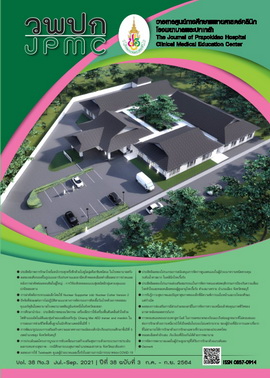Efficacy of the New Automated External Defibrillator Trainer and Basic Life Support Manikin (Chiang Mai Model) in Basic Life Support Teaching in First-Year Medical Students: A Pilot Study
Main Article Content
Abstract
BACKGROUND: Thailand has limited resources for Basic Life Support (BLS) training courses. There are not enough tools for BLS quality assessment or Automated External Defibrillator (AED) training. We have designed new manikins and AED trainers for BLS training.
OBJECTIVES: We aimed to evaluate the quality of Chiang Mai manikins and Chiang Mai AED trainers in BLS training.
METHODS: This was a randomized controlled pilot trial. First-year medical students were randomized into four groups: Group A was trained with a Chiang Mai manikin and Chiang Mai AED trainer, Group B was trained with a Chiang Mai manikin and a commercial AED trainer, Group C was trained with a commercial manikin and Chiang Mai AED trainer, and Group D was trained with a commercial manikin and a commercial AED trainer. The post-test results were compared between each group by using theoretical test results and practice test results.
RESULTS: There were 10, 11, 12, and 12 students in group A, B, C, and D. Theoretical test result median with their 25th and 75th percentiles were 9 (8, 9), 9 (7, 9), 9 (8, 9), and 9 (8.25, 9), respectively. Practice test result median with their 25th and 75th percentiles were 26 (26, 26), 25 (23, 26), 23.5 (22.25, 25), and 24 (24, 25.75), respectively. We found no statistical difference between the theoretical test results (p = 0.8) and the practice test results (p < 0.05) between each group.
CONCLUSIONS: Chiang Mai manikins and Chiang Mai AED trainers are equally effective as other commercial manikins and commercial AED trainers in BLS training.
Article Details
References
Kleinman ME, Brennan EE, Goldberger ZD, Swor RA, Terry M, Bobrow BJ, et al. Part 5: Adult basic life support and cardiopulmonary resuscitation quality: 2015 American Heart Association guidelines update for cardiopulmonary resuscitation and emergency cardiovascular care. Circulation 2015;132(18 Suppl 2):S414-35.
National Statistical Office. Number of deaths by cause of death and sex across the Kingdom of Thailand, 2007-2014 [Internet]. Bureau of International Health, Ministry of Public Health,Thailand; 2014 [cited 2017 Feb 1]. Available from: http://service.nso.go.th/nso/web/statseries/statseries09.html
National Institute of Emergency Medical. ITEM3 16 Event type 2012-2017 [Internet].2017 [cited 2017 Feb 1]. Available from: https://ws.niems.go.th/ITEMS_DWH/report016.aspx
Kronick SL, Kurz MC, Lin S, Edelson DP, Berg RA, Billi JE, et al. Part 4: Systems of care and continuous quality improvement: 2015 American Heart Association guidelines update for cardiopulmonary resuscitation and emergency cardiovascular care. Circulation 2015;132(18 Suppl 2):S397-413.
Chan PS, McNally B, Tang F, Kellermann A. Recent trends in survival from out-of-hospital cardiac arrest in the United States. Circulation 2014;130:1876-82.
National Institute Emergency Medicine. Announcement of the National Institute Emergency Medicine service commission subject: The use of an automated external defibrillator as first aid machine [Internet]. 2015 [cited 2017 Feb 14]. Available from: https://www.niems.go.th/1/Ebook/Detail/783?group=10.
Bhanji F, Donoghue AJ, Wolff MS, Flores GE, Halamek LP, Berman JM, et al. Part 14: Education: 2015 American Heart Association guidelines update for cardiopulmonary resuscitation and emergency cardiovascular care. Circulation 2015;132(18 Suppl 2):S561-73.
Lee JH, Cho Y, Kang KH, Cho GC, Song KJ, Lee CH. The effect of the duration of basic life support training on the learners' cardiopulmonary and automated external defibrillator skills. Biomed Res Int [Internet]. 2016 [cited 2017 Feb 1];2016:2420568. Available form: https://downloads.hindawi.com/journals/bmri/2016/2420568.pdf
Yeung J, Davies R, Gao F, Perkins GD. A randomised control trial of prompt and feedback devices and their impact on quality of chest compressions—a simulation study. Resuscitation 2014;85:553-9.
Wee JC, Nandakumar M, Chan YH, Yeo RS, Kaur K, Anantharaman V, et al. Effect of using an audiovisual CPR feedback device on chest compression rate and depth. Ann Acad Med Singap 2014;43:33-8.
Cheng A, Brown LL, Duff JP, Davidson J, Overly F, Tofil NM, et al. Improving cardiopulmonary resuscitation with a CPR feedback device and refresher simulations (CPR CARES Study): a randomized clinical trial. JAMA Pediatr 2015;169:137-44.
Fischer H, Gruber J, Neuhold S, Frantal S, Hochbrugger E, Herkner H, et al. Effects and limitations of an AED with audiovisual feedback for cardiopulmonary resuscitation: a randomized manikin study. Resuscitation 2011;82:902-7.
Sutham K, Laosuksri W, Wittayachamnankul B, Chenthanakij B, Rangsri W, Pongvuthitham R, et al. Innovative Chiang Mai manikin trainer for basic life support training. CDEM J 2020;1(2):13-22.
Laosuksri W, Chenthanakij B, Rangsri W, Pongvuthitham R, Rungsiyakull C, Sucharitakul T, et al. Development controller and feedback of Chiang Mai automated external defibrillation trainer and manikin for basic life support training. Chaing Mai Med J 2021;60: 87-97.

